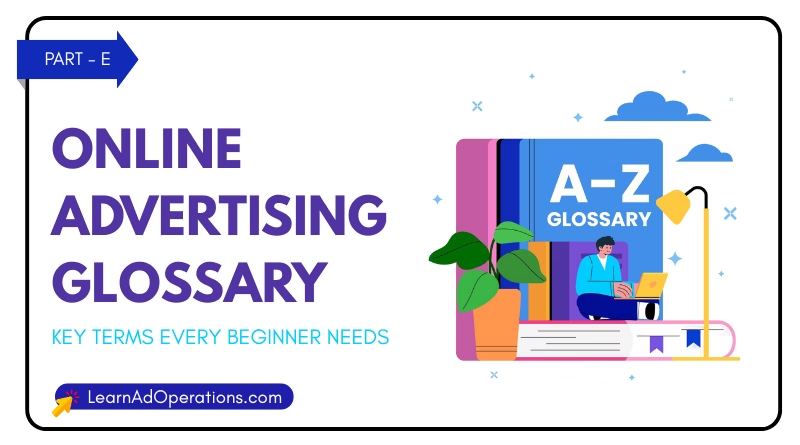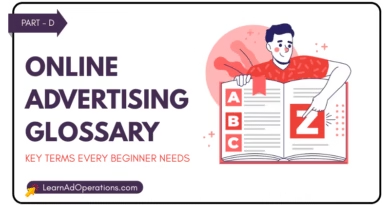Digital Advertising Glossary: ‘E’ Terms Every Beginner Should Know
Starting out in digital advertising can feel overwhelming – almost like learning a new language. With countless terms used across programmatic advertising, email marketing, event tracking, and campaign optimization, beginners often struggle to keep up. That’s why we’ve created this beginner-friendly digital marketing glossary series, designed to simplify and explain the essential advertising terms every new marketer should know.
In this edition, we spotlight key digital advertising terms that start with the letter “E”. Whether you want to boost audience engagement, improve ad performance tracking, or implement email retargeting strategies, this glossary will help you build a solid foundation in understanding campaign setup, performance metrics, and targeting techniques. Mastering these terms will accelerate your learning and sharpen your marketing strategy in no time.
E
eCPM: Measures how much revenue is generated for every 1,000 impressions that are served, and is calculated by dividing a campaign’s revenue by the total number of impressions and multiplying that value by 1,000.
EUID: Built for advertisers in Europe and specific to regional regulations, EUID uses data to identify and reach consumers with relevant advertising across channels and devices.
Excess potential: The additional budget an ad group can spend during a day without changing any targeting settings.
Expandable: An online display ad that expands to a larger ad format when viewers scroll over it.
Expressiveness: A measurement of the number of unique bid combinations possible for a strategy that is calculated by using the unique nonzero bid factors applied to each dimension.
Email Retargeting: Email retargeting is a strategy that uses data from email interactions to serve personalized ads across the web. It helps reconnect with users who opened or clicked on your emails but didn’t convert.
Are you looking to learn Online Advertising jargons? Here is the comprehensive online advertising glossary for beginners to learn digital marketing key terms from our Online Advertising Glossary.
Engagement Rate: This metric shows how actively users interact with your ads—through clicks, shares, comments, or video views. A high engagement rate often indicates your content is relevant and compelling.
Event Tracking: Event tracking lets marketers monitor specific user actions on a website or app—like form submissions, downloads, or button clicks. It provides deeper insight into how users engage beyond simple page views.
Exit Rate: Exit rate measures the percentage of users who leave your site from a specific page. It helps identify pages where users lose interest or complete their journey.
Exclusion Targeting: This technique prevents your ads from showing to certain audiences, such as existing customers or irrelevant demographics. It saves ad spend and improves targeting efficiency.
Expanded Audience Targeting: A feature in some ad platforms that allows you to reach additional people beyond your selected audience. It uses AI to find similar users who may also convert.
Earned Media: Earned media refers to publicity gained through organic methods like shares, mentions, reviews, or media coverage. It’s free and often reflects high brand trust and value.
Event-Based Attribution: A method of tracking the specific actions (or “events”) that lead to a conversion, such as video views or ad clicks. It helps marketers understand which user behaviors drive results.
Exit Intent Popups: These popups appear when a user is about to leave a site, offering discounts or content to keep them engaged. They’re often used to reduce cart abandonment or capture leads.
External Attribution Tool: A third-party solution that helps brands measure the effectiveness of their marketing efforts across channels. It offers unbiased insights beyond what ad platforms report themselves.
Eye-Tracking Analysis: A technique that analyzes where users look on a screen to determine what catches their attention. It’s used to optimize ad design, placement, and user experience.
Express Campaigns: Simplified, automated ad campaigns (often in platforms like Google Ads) designed for small businesses or beginners. They require minimal setup and rely on AI to manage targeting and bidding.
End Card (in Video Ads): An end card is a static screen shown at the end of a video ad, often featuring a call-to-action (CTA), branding, or download link. It’s designed to drive post-view engagement.
Embedded Ads: Ads placed directly within digital content, like in videos or articles, that appear as part of the experience. These are less intrusive and blend in more naturally with content.
Email Drip Campaign: A sequence of pre-written marketing emails sent automatically based on user behavior or a schedule. They help nurture leads or onboard new users.
Entry Page: The first page a user lands on after clicking a digital ad. Also called a landing page, its content should match the ad to avoid bounce and improve conversions.
Event-Based Retargeting: This method shows ads to users based on specific actions they’ve taken, such as watching a video or abandoning a cart. It’s more personalized than general site retargeting.
Estimated Action Rate: A prediction made by ad platforms (like Meta Ads) about how likely a user is to take a desired action (like clicking or converting). It’s used to optimize ad delivery.
Early Funnel Metrics: These are metrics like impressions, reach, and clicks that occur at the top of the marketing funnel. They help track awareness and interest before users convert.
Environment Targeting: Targeting based on the digital environment where the ad appears—like mobile apps, desktop browsers, or in-game placements. Ensures ads are shown where they’re most effective.
Email Match (in Audience Building): The process of matching a brand’s email list with user profiles on an ad platform. This allows advertisers to target or exclude specific email audiences in campaigns.
Conclusion
Mastering digital advertising starts with knowing the terminology – and the letter “E” introduces many essential concepts that directly impact campaign performance and targeting strategies. As you build your digital marketing knowledge, use these definitions as reference points to create smarter strategies and interpret your results more confidently. Stay tuned for the next article in our A–Z glossary series to continue expanding your marketing vocabulary!
Source: The Trade Desk




